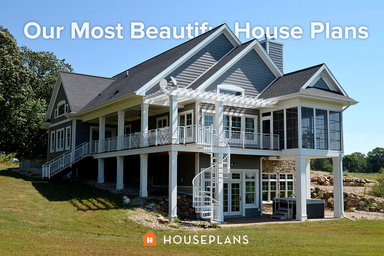What is a cornice, an entablature, a frieze? How does each of these relate to the other? And how can these exterior architectural elements be used to add curb appeal to a home’s exterior?To begin to answer these questions, let’s start with a glossary of exterior trim elements.
Symmetrical and formal, a Colonial home will feature exterior trim derived from Classical sources. The trim elements will then be items such as columns, pediments, entablatures, etc. These houses will also typically feature an entry door that is set in the middle of the elevation and have side lights for added emphasis.
A small entry portico will draw attention to the front door while adding formality to the overall look of the home. This portico is usually one story in height and will have a railing (such as a Chinese Chippendale rail) or pediment, the triangularly shaped wall at a gable end, to finish the top.
To further emphasize the symmetry and formality of the home, pilasters are added at the corners of the exterior. These pilasters, simply shallow column like elements that are attached to a wall, usually rise the full height of the exterior, acting as bookends that keep the overall composition static.
At the base, just above the foundation, is the water table. This tall, flat band wraps around the home’s exterior to give a visual base as well as provide a starting point for the exterior finish such as horizontal lap siding. The water table is capped with a drip cap to prevent water from spilling down the water table. Because the drip cap is deeper than the water table, it creates a distinctive shadow line that can be used as a design element.
At the top of the pilasters and upper story windows is the entablature which is composed of an architrave, frieze and cornice. In succession, the architrave is the visual band that rests on top of opening, such as windows, that provides a continuous horizontal to tie these openings together. The frieze sits on the architrave and provides a transition to the cornice, which is the element upon which the roof will rest.
A raked cornice is the cornice that follows the pitched roof line and a cornice return is when the raked cornice flattens to a horizontal and continues along the bottom of the pediment.
Lastly, the columns that are used to support porticos and porch roofs will usually be based on the Classical Orders of Doric, Corinthian, Ionic and Tuscan. And each column, no matter what its shape or style, will have a base, shaft and capital.
Symmetrical and formal, a Colonial home will feature exterior trim derived from Classical sources. The trim elements will then be items such as columns, pediments, entablatures, etc. These houses will also typically feature an entry door that is set in the middle of the elevation and have side lights for added emphasis.
A small entry portico will draw attention to the front door while adding formality to the overall look of the home. This portico is usually one story in height and will have a railing (such as a Chinese Chippendale rail) or pediment, the triangularly shaped wall at a gable end, to finish the top.
To further emphasize the symmetry and formality of the home, pilasters are added at the corners of the exterior. These pilasters, simply shallow column like elements that are attached to a wall, usually rise the full height of the exterior, acting as bookends that keep the overall composition static.
At the base, just above the foundation, is the water table. This tall, flat band wraps around the home’s exterior to give a visual base as well as provide a starting point for the exterior finish such as horizontal lap siding. The water table is capped with a drip cap to prevent water from spilling down the water table. Because the drip cap is deeper than the water table, it creates a distinctive shadow line that can be used as a design element.
At the top of the pilasters and upper story windows is the entablature which is composed of an architrave, frieze and cornice. In succession, the architrave is the visual band that rests on top of opening, such as windows, that provides a continuous horizontal to tie these openings together. The frieze sits on the architrave and provides a transition to the cornice, which is the element upon which the roof will rest.
A raked cornice is the cornice that follows the pitched roof line and a cornice return is when the raked cornice flattens to a horizontal and continues along the bottom of the pediment.
Lastly, the columns that are used to support porticos and porch roofs will usually be based on the Classical Orders of Doric, Corinthian, Ionic and Tuscan. And each column, no matter what its shape or style, will have a base, shaft and capital.






